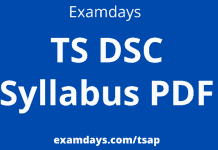TS SBTET C18 Syllabus: State Board of Technical Education Training of Telangana State (TS SBTET) released C-18 Semester 2 DIPLOMA IN ARCHITECTURAL ASSISTANTSHIP (DAA) syllabus for the latest academic year. The TS SBTET Candidates have to note down the complete DAA syllabus and same follow the instructions from TS SBTET Board and ut rules and regulations.
For TS SBTET C18 Syllabus Download, candidates can check the detailed exam syllabus for the course wise and semesters wise details.
TS SBTET C18 Syllabus
The syllabus is available for the below semester wise;
- TS SBTET c18 syllabus pdf 5th sem
- TS SBTET c18 syllabus pdf 4th sem
- TS SBTET c18 syllabus pdf 2nd sem
- TS SBTET c18 3rd sem syllabus
- TS SBTET c18 6th sem syllabus
- TS SBTET c18 1st sem syllabus
- TS SBTET c18 4th sem syllabus
- TS SBTET c18 5th sem syllabus
- TS SBTET c18 syllabus
Download DIPLOMA IN ARCHITECTURAL ASSISTANTSHIP Syllabus
Unit1: Architectural Symbols
1.1 Meaning of the term architectural symbols
1.2 Symbols forbuilding materials
1.3 Symbols forbuilding elements like doors, windows, chajjas, steps,etc.
1.4 Electrical symbols like switch board, light, fan etc.
1.5 Plumbing symbols like wash basin, water closet, bath tub,etc.
1.6 Furniture symbols like bed, sofa, dinng chair and table.
1.7 Plant material symbols like trees, shrubs and ground covers.
Unit2: Anthropometric Data
2.1 Basic measurements of an average adult human being in different postures
2.2 Proportions of body parts and graphic presentation
Unit3: Design Process
- Study of functional spaces, areas and furniture arrangements
- Study of human considerations like privacy, convenience, light, ventilation, view, etc.
- Study of design considerations like culture, context, circulation.
- Case study of a small house and critical appraisal of the spaces
- Pre design study- user requirements and study of site and its environs.
Unit4: Scale and Measured Drawings
4.1 Brief enlarged and reduced scales
4.1 Measure an EWS/LIG house and prepare measured drawings in plan, elevation and section
Unit5: Design of Kiosks
5.1 Design of a Kiosks – milk booth, watchman’s room, flower stall, ATM Center, traffic police kiosk.
5.2 Draw plan and elevation
Unit 6 : EWS/LIG/MIG Houses
6.1 Integration of form and function in the design of EWS/LIG/MIG houses
6.2 Importance of circulation diagrams as graphic tools
TS SBTET C-18 II Semester Complete Syllabus
ARCHITECTURAL GRAPHICS
Unit1: Rendering
- Rendering techniques for various materials used in buildings
- Techniques for various floor finishes
- Rendering windows and shadows
- Rendering rocks, water bodies, plant material
- Rendering human beings and cars
Unit2: Still Life
2.1 Sketch a group of 1/2/3 to 5 simple objects placed in front of the students.
2.2 Objects should be of good form based on basic geometric/ non geometric shapes
2.3 Students should be able to render tonal values in colour or gray scale.
2.4 The objects may be arranged on the floor or above at some suitable height.
2.5 Medium of drawing is pencil/water or poster colour, crayons or colour pencil
Unit3: Nature Drawing
- Sketching plant material in various forms- trees, shrubs
- Sketching foliage, flowers and fruits and render them
3.3 To make an enlarged drawing of parts of a plant such as joints, stems, knots, petals, etc.
3.4 The medium of drawing is pencil and water colour
Unit4: Man made Environment
4.1 Architectural graphics – drawing human figures in various postures
4.2 Buildings- sloping roof, heritage building and a modern building
4.2 Cars in relation to a building and surroundings
Unit5: Landscapes
5.1 Landscape graphics – elements like sky, water, plant material, rockery,buildings, bridges
Unit 6 : Memory Drawing
6.1 To draw simple familiar objects( animate and inanimate)in pencil and colour
6.2 Visit to a park, fair, circus
6.3 Scene related to family festivities- a birthday party, a festival
6.4 National festivals
6.5 Public spaces like a railway station or a bus stand
6.6The medium of drawing is pencil or wax crayons
If students have any questions, can comment below with valid questions and doubts, our team member will assist you as soon as possible.
Download DIPLOMA IN ARCHITECTURAL ASSISTANTSHIP Syllabus PDF
Download Diploma in Automobile Engineering Syllabus
UNIT- 1: HEAT ENGINES :
Automobile Definition – Classification of an Automobile – Layout of a typical Automobile –Chassis – definition, Engine mounts – need – types, definition of : Wheel base – Wheel track – Overall length – Front overhung – Rear overhung – Height of C.G – Ground clearance – Gross weight and Kerb weight.
Heat engines – Definition – Types of heat engines – Comparison of IC and EC engines. Engine Terminology- bore – stroke – TDC – BDC – clearance volume – swept volume – total volume – Compression ratio – mean effective pressure – indicated power – brake power – friction power – engine Speed- engine torque, Classification of IC engines with respect to different parameters, Number of Cylinders-Arrangement of Cylinders etc.,- Over head valve arrangement – Side valve arrangement – L, I, F and T – type valve arrangements . Two Stroke & four stroke – SI engines-construction and working – CI engines construction and working – Comparison of SI and CI engines – Advantages and limitation of diesel engine over a petrol engine – Comparison of Two stroke and Four stroke engines – Scavenging. Valve timing diagram of 2- stroke & 4- stroke Petrol & Diesel engines – Firing Order – General Firing Orders of 4, 6 and 8 cylinder engines.
Inlet and Exhaust System – Air Cleaners – Construction details of various types of air cleaners – Paper filter type air cleaner, Oil bath and Oil wetted type – Inlet and Exhaust Manifolds- Constructional details – Mufflers – types of Mufflers – Constructional details and working principle of various types of Mufflers.
UNIT-2: ENGINE CONSTRUCTION
Engine – Cylinder Block- Cylinder Liners- CylinderHead–Crankcase andOilPan–Gaskets–Piston, Pistontypes–PistonPinandPistonRings–Connecting Rod– ConnectingRodbearings–Crankshaft– MainBearings– Need of oilClearance– Flywheel– Vibrationdampers-Valves- Valve springs – Valve Seat – Valve guide bushing and oil seal – Cam Shaft – Valve Lifter, Pushrod and Rocker arm-mention material used and method of manufacturing.
UNIT-3. BASIC FUEL SYSTEM:
Fuels -Definition of fuel – Classification of fuels – Properties of fuels – Calorific value of fuels – H.C.V & L.C.V -Fuels used in I.C. Engines – Rating of I.C engine fuels – Octane rating, Cetane rating- Fuel dopes or additives. Combustion of fuels – Introduction – Combustion limits of air and fuel mixtures – Stochiometric ratio – Homogeneous mixture – Heterogeneous mixture – Air fuel ratios for different operating conditions.
Petrol Engine Fuel systems – Line diagram of petrol engine fuel supply systems – components -constructional details of fuel tank, fuel lines and fuel filters – working principle with constructional details of fuel pumps-Mechanical and Electrical – constructional details of simple carburetor. Defects in simple carburetor – List of various circuits in Automobile carburetors and their purpose – Classification of carburetors – Down draught, up draught and side draught, ConstantChokeandConstant VacuumtypeCarburetors.
TRANSMISSION BASICS: Duration:
Purposes of the automotive transmission system – Arrangement of transmission in automotive vehicle – Functions of various components in the transmission – Function of a clutch-Principle of Operation-General requirements of an automobile clutch- Constructional details of different types of clutches -Single plate Clutch – Coil Spring type and Diaphragm spring clutch – Multi plate – Centrifugal – Semi centrifugal –- Working principles of vacuum and hydraulically operated clutches.
5.CHASSIS AND BODY BASICS:
Chassis frame – Functions of the frame, types of chassis frames – Brief description of their-constructional features -various loads acting on the frame.
Motor Vehicle Body– Requirements of automobile body – Conventional type –Unitized type–Types of vehicles according to bodies –Private and Commercial use – Private vehicle bodies – Sedan, Saloon, Convertibles, 2-door, 4-door etc.,–Commercial vehicle bodies–different passenger vehicle bodies – Goods transport vehicles – Special purpose vehicle bodies like water carriers, delivery vans, trucks, station wagons, tippers, ambulance vehicles, fire fighting vehicles – cell pool and gully water removal vehicles of municipality , break down service vehicles, goods transport vehicles for depots.
6.Lubrication and Cooling Systems:
Typesoflubricants– Properties required for alubricating oil – viscosity-FireandFlashpoints etc.., – Grading of Lubricating oils – S.A.E and API systems – GradesofLubricantsused for : Engine,Gear-Box,Differential -Types of lubrication systems used in Automobiles – Petroil type – Splash type and force feed lubrication system – Dry Sump and Wet sump Lubrication -Typesof oil filters-FullflowandBy-passfilter arrangements –Additives used for syntheticLubricants.
Necessity of cooling- Disadvantages of over cooling and under cooling – Types ofcoolingsystems – Aircooling, WaterCooling and Liquid cooling – ConstructionaldetailsofanAircooled engine- Thermosiphon system – Forcefeedtypecooling systems – Radiator pressure cap used in pressure cooling system.
–Constructional details and working principle of water pump – Radiator -core- Different types and their constructional details -Thermostat- Wax pellet type and Bellows type – Anti freezing additives – Antirustingadditives.
If students have any questions can comment below for further discussions on Diploma Syllabus 2018, Our team member will assist you as soon as possible.







